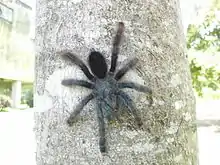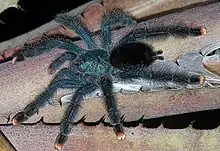Avicularia avicularia
Avicularia avicularia, sometimes called the pinktoe tarantula, is a species of tarantula native from Costa Rica to Brazil and the southern Caribbean. This species is sometimes called the Guyana pinktoe, common pinktoe, or South American pinktoe.
| Pinktoe tarantula | |
|---|---|
 | |
| Scientific classification | |
| Kingdom: | Animalia |
| Phylum: | Arthropoda |
| Subphylum: | Chelicerata |
| Class: | Arachnida |
| Order: | Araneae |
| Infraorder: | Mygalomorphae |
| Family: | Theraphosidae |
| Genus: | Avicularia |
| Species: | A. avicularia |
| Binomial name | |
| Avicularia avicularia | |
| Synonyms | |
| |
The mature pinktoe tarantula has a dark-colored body and pinkish feet, hence its name. Juvenile specimens, however, have pinkish bodies and dark-colored feet. Pinktoe tarantulas undergo a reversal in their coloration as they approach adulthood at 4–5 years. They have a short lifespan, with males living 2-3 years, and females living between 6-9 years.[1] A full grown pinktoe tarantula can grow up to six inches in length. Dimorphism has been shown in the mature stages of males and females, with males having uniformly barbed urticating hairs, while females are found only at the proximal end.[2]
They are an ambush predator, using the silk spun as a trap and to sense movement from prey. With an enriched environment, they can display an array of behaviors such as active hunting, foraging, and even construction such as nest and tunnel building with nearby debris.[3]
Being arboreal species, they require a relatively tall habitat with plenty of climbing space in captivity. Despite common belief, this species should be kept on dry substrate with a water dish to achieve adequate humidity while also giving cross ventilation. This prevents stagnant air, bacteria, and excessive humidity from forming which can be fatal.[4]
Their first reaction when threatened is usually to run or leap away, but they may react aggressively if provoked. Their venom is considered mild, even compared to other new-world tarantulas.[5] Although this species is often rumored to be communal, housing them in groups will almost inevitably lead to cannibalism over time. Females are also shown to display sexual cannibalism.[6]

See also
References
- "World spider catalog". NMBE - World Spider Catalog.
- Stradling, David J (2008). The growth and maturation of the “tarantula”, Avicularia avicularia L. Zoological Journal of the Linnean Society. pp. 291–303.
- 1. J. L. Cloudsley‐Thompsona & C. Constantinou. 1985. Diurnal rhythm of activity in the arboreal tarantula Avicularia avicularia (L.) (Mygalomorphae: Theraphosidae). Journal of Interdisciplinary Cycle Research. Retrieved January 25, 2012.
- Pinto, Leite (2008). Non random patterns of spider composition in an Atlantic Rainforest. Brazil: Journal of Arachnology 36. pp. 448–452.
- "Are Tarantulas Poisonous?". DesertUSA.
- Rabaneda-Bueno, R; Rodríguez-Gironés, MÁ; et al. (2008). Sexual Cannibalism: High Incidence in a Natural Population with Benefits to Females. PLoS ONE.
External links
| Wikimedia Commons has media related to Avicularia avicularia. |
- Avicularia avicularia photos in tarantulas gallery
- Avicularia avicularia on the Tarantupedia